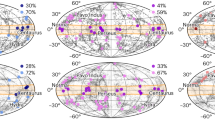Abstract
The rate of star formation in a galaxy is often determined by the observation of emission in the Hα line, which is related to the presence of short-lived massive stars. Disk galaxies show a strong cut-off in Hα radiation at a certain galactocentric distance, which has led to the conclusion that star formation is suppressed in the outer regions of disk galaxies. This is seemingly in contradiction to recent observations1 in the ultraviolet which imply that disk galaxies have star formation beyond the Hα cut-off, and that the star-formation-rate surface density is linearly related to the underlying gas surface density, which is a shallower relationship than that derived from Hα luminosities2. In a galaxy-wide formulation, the clustered nature of star formation has recently led to the insight that the total galactic Hα luminosity is nonlinearly related to the galaxy-wide star formation rate3. Here we show that a local formulation of the concept of clustered star formation naturally leads to a steeper radial decrease in the Hα surface luminosity than in the star-formation-rate surface density, in quantitative agreement with the observations, and that the observed Hα cut-off arises naturally.


Similar content being viewed by others
References
Boissier, S. et al. Radial variation of attenuation and star formation in the largest late-type disks observed with GALEX. Astrophys. J. Suppl. Ser. 173, 524–537 (2007)
Kennicutt, R. C. The global Schmidt law in star-forming galaxies. Astrophys. J. 498, 541–552 (1998)
Pflamm-Altenburg, J., Weidner, C. & Kroupa, P. Converting Hα luminosities into star formation rates. Astrophys. J. 671, 1550–1558 (2007)
Vanbeveren, D. Theoretical evolution of massive stellar aggregates. Astron. Astrophys. 124, 71–76 (1983)
Weidner, C. & Kroupa, P. The variation of integrated star initial mass functions among galaxies. Astrophys. J. 625, 754–762 (2005)
Weidner, C., Kroupa, P. & Larsen, S. S. Implications for the formation of star clusters from extragalactic star formation rates. Mon. Not. R. Astron. Soc. 350, 1503–1510 (2004)
Weidner, C. & Kroupa, P. Evidence for a fundamental stellar upper mass limit from clustered star formation. Mon. Not. R. Astron. Soc. 348, 187–191 (2004)
Köppen, J., Weidner, C. & Kroupa, P. A possible origin of the mass-metallicity relation of galaxies. Mon. Not. R. Astron. Soc. 375, 673–684 (2007)
Hoversten, E. A. & Glazebrook, K. Evidence for a nonuniversal stellar initial mass function from the integrated properties of SDSS galaxies. Astrophys. J. 675, 163–187 (2008)
Lada, C. J. & Lada, E. A. Embedded clusters in molecular clouds. Annu. Rev. Astron. Astrophys. 41, 57–115 (2003)
Kennicutt, R. C. et al. Star formation in NGC 5194 (M51a). II. The spatially resolved star formation law. Astrophys. J. 671, 333–348 (2007)
Zasov, A. V. & Abramova, O. V. The star-formation efficiency and density of the disks of spiral galaxies. Astron. Rep. 50, 874–886 (2006)
Kroupa, P. On the variation of the initial mass function. Mon. Not. R. Astron. Soc. 322, 231–246 (2001)
Kroupa, P. The initial mass function of stars: Evidence for uniformity in variable systems. Science 295, 82–91 (2002)
Kennicutt, R. C. The star formation law in galactic disks. Astrophys. J. 344, 685–703 (1989)
Ferguson, A. M. N., Wyse, R. F. G., Gallagher, J. S. & Hunter, D. A. Diffuse ionized gas in spiral galaxies: Probing Lyman continuum photon leakage from H II regions? Astron. J. 111, 2265–2279 (1996)
Zaritsky, D. & Christlein, D. On the extended knotted disks of galaxies. Astron. J. 134, 135–141 (2007)
Thilker, D. A. et al. Recent star formation in the extreme outer disk of M83. Astrophys. J. 619, L79–L82 (2005)
Lelièvre, M. & Roy, J.-R. The H II regions of the extreme outer disk of NGC 628. Astron. J. 120, 1306–1315 (2000)
Toomre, A. On the gravitational stability of a disk of stars. Astrophys. J. 139, 1217–1238 (1964)
Cowie, L. L. Cloud fluid compression and softening in spiral arms and the formation of giant molecular cloud complexes. Astrophys. J. 245, 66–71 (1981)
Hunter, D. A., Elmegreen, B. G. & van Woerden, H. Neutral hydrogen and star formation in the irregular galaxy NGC 2366. Astrophys. J. 556, 773–800 (2001)
Elmegreen, B. G. & Hunter, D. A. Radial profiles of star formation in the far outer regions of galaxy disks. Astrophys. J. 636, 712–720 (2006)
Krumholz, M. R. & McKee, C. F. A minimum column density of 1 g cm-2 for massive star formation. Nature 451, 1082–1084 (2008)
Kenney, J. D. P. & Young, J. S. The effects of environment on the molecular and atomic gas properties of large Virgo cluster spirals. Astrophys. J. 344, 171–199 (1989)
Wong, T. & Blitz, L. The relationship between gas content and star formation in molecule-rich spiral galaxies. Astrophys. J. 569, 157–183 (2002)
Schuster, K. F., Kramer, C., Hitschfeld, M., Garcia-Burillo, S. & Mookerjea, B. A complete 12CO 2–1 map of M 51 with HERA. I. Radial averages of CO, HI, and radio continuum. Astron. Astrophys. 461, 143–151 (2007)
Crosthwaite, L. P. & Turner, J. L. CO(1–0), CO(2–1), and neutral gas in NGC 6946: Molecular gas in a late-type, gas-rich, spiral galaxy. Astron. J. 134, 1827–1842 (2007)
Kennicutt, R. C., Tamblyn, P. & Congdon, C. E. Past and future star formation in disk galaxies. Astrophys. J. 435, 22–36 (1994)
Martin, C. L. & Kennicutt, R. C. Star formation thresholds in galactic disks. Astrophys. J. 555, 301–321 (2001)
Acknowledgements
We thank K. S. de Boer for discussions.
Author information
Authors and Affiliations
Corresponding author
Supplementary information
Supplementary Information
This file contains a Supplementary Discussion, Supplementary Table 1 and Supplementary Figures 1-3 with Legends (PDF 230 kb)
PowerPoint slides
Rights and permissions
About this article
Cite this article
Pflamm-Altenburg, J., Kroupa, P. Clustered star formation as a natural explanation for the Hα cut-off in disk galaxies. Nature 455, 641–643 (2008). https://doi.org/10.1038/nature07266
Received:
Accepted:
Issue Date:
DOI: https://doi.org/10.1038/nature07266
- Springer Nature Limited





